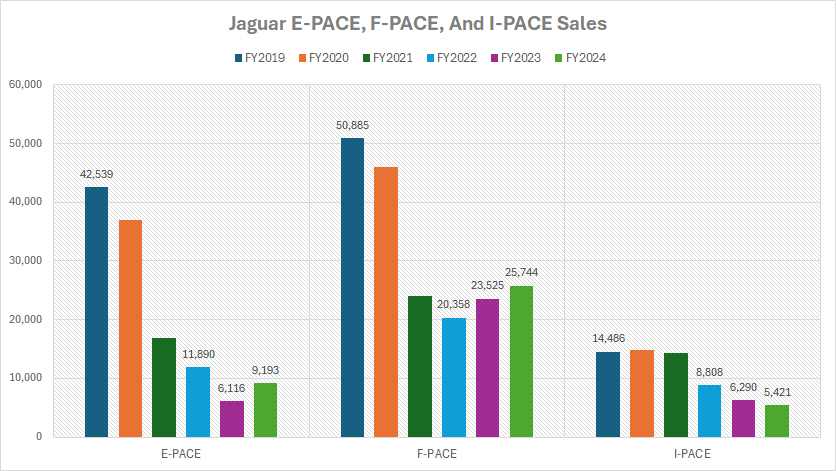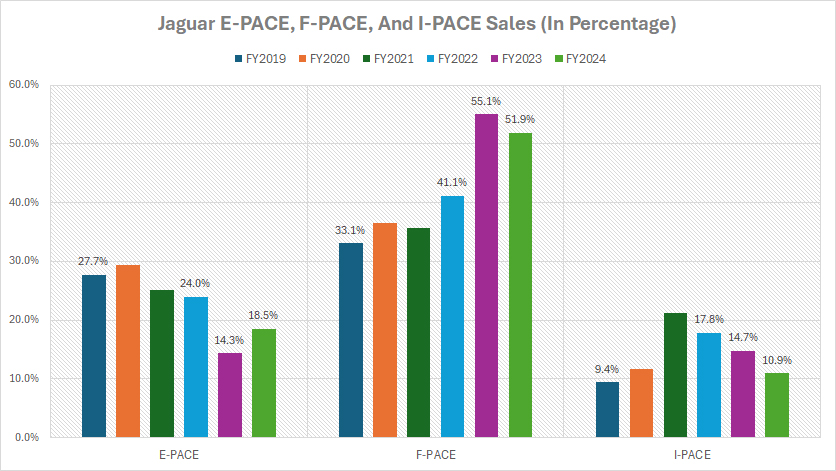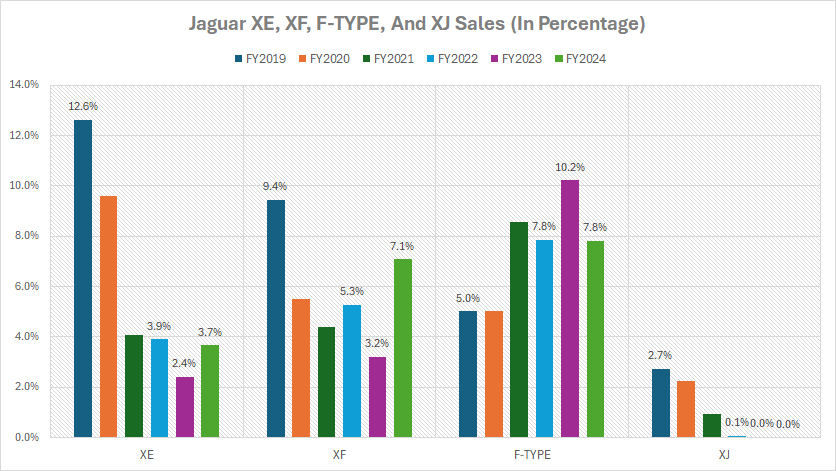
Jaguar vehicles. Pexels Image.
This article presents Jaguar’s vehicle sale by model. For your information, Jaguar is a luxury vehicle brand of Jaguar Land Rover, a British multinational car manufacturer with headquarters in Whitley, Coventry, England.
Jaguar is part of Jaguar Land Rover (JLR), which is a subsidiary of Tata Motors, an Indian automotive company, since 2008. Jaguar’s lineup includes a variety of vehicles such as sedans (like the Jaguar XF), sports cars (like the F-TYPE), and SUVs (like the F-PACE and E-PACE).
Jaguar has a strong focus on innovation, particularly in electric vehicles. The Jaguar I-PACE, an all-electric SUV, has won numerous awards for its performance and design.
The vehicle sales data presented in this article uses the wholesale numbers, which may differ significantly from the retail-based numbers. For a detail explanation of wholesale, please visit this section: vehicle wholesale.
Let’s get into the details!
Investors looking for detailed sales statistics of Jaguar Land Rover can find more information on these pages: JLR sales by country, Jaguar best selling car, and JLR global sales volume.
Please use the table of contents to navigate this page.
Table Of Contents
Definitions And Overview
Consolidated Results
A1. Global Sales
Sales Of Top Models
B1. Sales Of E-PACE, F-PACE, And I-PACE
B2. Sales Of E-PACE, F-PACE, And I-PACE In Percentage
B3. Sales Growth Of E-PACE, F-PACE, And I-PACE
Sales Of Other Models
C1. Sales Of XE, XF, F-TYPE, And XJ
C2. Sales Of XE, XF, F-TYPE, And XJ In Percentage
C3. Sales Growth Of XE, XF, F-TYPE, And XJ
Summary And Reference
S1. Conclusion
S2. References and Credits
S3. Disclosure
Definitions
To help readers understand the content better, the following terms and glossaries have been provided.
Wholesale: Wholesale for automobile companies refers to the sale of vehicles from manufacturers to dealerships, distributors, or other businesses, rather than to individual consumers. Here are some key points:
- Bulk Sales: Wholesale transactions typically involve the sale of multiple vehicles in large quantities, which allows manufacturers to move inventory more efficiently.
- Pricing: Wholesale prices are usually lower than retail prices because they do not include the additional costs associated with selling to individual consumers, such as marketing and dealership overhead.
- Distribution Channels: Automobile manufacturers often have established networks of dealerships and distributors who purchase vehicles at wholesale prices and then sell them to the end consumers.
- Inventory Management: Wholesale helps manufacturers manage their production schedules and inventory levels by ensuring a steady flow of vehicles to the market.
- Incentives: Manufacturers may offer incentives, such as volume discounts or financing deals, to encourage dealerships and distributors to purchase more vehicles.
By focusing on wholesale transactions, automobile companies can streamline their operations and ensure that their vehicles reach a wide market efficiently.
Jaguar Vehicle Lineup: Jaguar’s vehicle lineup includes a variety of luxury and performance-oriented cars and SUVs. Here’s an overview of its current models:
SUVs:
1. Jaguar F-PACE: A mid-size luxury SUV that combines sporty handling with the practicality of an SUV. It offers a range of powerful engines and premium interiors.
2. Jaguar E-PACE: A compact luxury SUV with a sporty design, agile handling, and modern technology features.
3. Jaguar I-PACE: An all-electric SUV that boasts impressive performance, a sleek design, and a substantial electric range.
Sedans:
1. Jaguar XE: A compact luxury sedan that offers a dynamic driving experience, elegant design, and advanced technology.
2. Jaguar XF: A mid-size luxury sedan with a focus on performance and sophistication, available in both sedan and Sportbrake (wagon) variants.
Sports Cars:
1. Jaguar F-TYPE: A high-performance sports car available in coupe and convertible body styles, known for its powerful engines and stunning design.
Discontinued Models:
1. Jaguar XJ: A full-size luxury sedan that was renowned for its luxurious interiors and smooth ride. Production has been discontinued, but it remains an iconic model in Jaguar’s history.
Upcoming Models:
Jaguar is focusing on transitioning to an all-electric lineup, with plans to introduce new electric vehicles in the near future as part of its Reimagine strategy.
This lineup reflects Jaguar’s commitment to blending luxury, performance, and cutting-edge technology.
Global Sales
Jaguar-global-sales
(click image to expand)
The definition of wholesale is available here: wholesale. Jaguar’s global vehicle sales have significantly declined since 2019, as shown in the chart above.
In fiscal year 2019, Jaguar’s global wholesale was more than 150,000 vehicles. However, the sales figure dipped to 49,600 vehicles as of fiscal year 2024, down nearly 70% in five years.
A key factor contributing to the decline in Jaguar’s vehicle wholesales is the shift in the automaker’s market strategy. For example, Jaguar has decided to focus on a more exclusive market segment, targeting truly wealthy customers rather than the mass market. This shift in strategy has resulted in reduced sales volumes.
Sales Of E-PACE, F-PACE, And I-PACE
Jaguar-sales-by-top-model
(click image to expand)
The definition of wholesale is available here: wholesale. The E-PACE, F-PACE, and I-PACE are Jaguar’s top-selling models. The definition of these models are available here: Jaguar vehicle lineup.
In fiscal year 2024, Jaguar sold 25,700 units of the F-PACE, while the E-PACE reached 9,200 units during the same period. The I-PACE was Jaguar’s third highest-selling car, with sales reaching 5,400 units in fiscal year 2024.
A noticeable trend is the significant decrease in sales for the F-PACE, E-PACE, and I-PACE models since fiscal year 2019, as depicted in the chart above.
For example, Jaguar delivered over 50,000 units of the F-PACE vehicle in fiscal year 2019. Sales dipped to just 25,700 units as of fiscal year 2024, roughly 50% lower in five years.
Similarly, Jaguar’s sales of the E-PACE have decreased by nearly 80% over five years, dropping from 42,500 units in fiscal year 2019 to 9,200 units in fiscal year 2024.
Sales Of E-PACE, F-PACE, And I-PACE In Percentage
Jaguar-sales-by-top-model-in-percentage
(click image to expand)
The definition of wholesale is available here: wholesale. The E-PACE, F-PACE, and I-PACE are Jaguar’s highest-selling vehicles. The definition of these models are available here: Jaguar vehicle lineup.
In fiscal year 2024, the Jaguar F-PACE accounted for 52% of the total sales volume, while the E-PACE accounted for 18.5%. Meanwhile, the I-PACE made up 11%. Combined, the F-PACE, E-PACE, and I-PACE models constituted 82% of Jaguar’s global vehicle volume.
An interesting trend is that the F-PACE is the only vehicle whose sales contribution has significantly risen since fiscal year 2019, increasing from 33% to 52% over five years.
Conversely, the sales contribution of Jaguar’s other models has either remained flat or declined since fiscal year 2015. This trend depicts the relative resilience of F-PACE sales, which are declining at a slower rate compared to the sharper downturn observed across the rest of the Jaguar lineup, as depicted in this section: sales of Jaguar F-PACE models.
Sales Growth Of E-PACE, F-PACE, And I-PACE
Jaguar-sales-growth-of-top-models
(click image to expand)
The definition of wholesale is available here: wholesale. The E-PACE, F-PACE, and I-PACE are Jaguar’s best-selling cars. The definition of these models are available here: Jaguar vehicle lineup.
As presented in the graph above, Jaguar F-PACE has experienced much slower rate of decline. In fact, the F-PACE sales have steadily grown over the last three years. On average, the sales growth of Jaguar F-PACE was roughly 3% per year between fiscal year 2022 and 2024.
In stark contrast, the E-PACE has faced a much steeper decline, with sales plummeting by an average of 9% annually between fiscal years 2022 and 2024. The I-PACE, however, has fared even worse, with an average annual sales decline of 27% between 2022 and 2024.
Sales Of XE, XF, F-TYPE, And XJ
Jaguar-sales-of-less-popular-models
(click image to expand)
The definition of wholesale is available here: wholesale. The XE, XF, F-TYPE, and XJ are among Jaguar’s less popular models. In fact, Jaguar has stopped producing the XJ. The definition of these models are available here: Jaguar vehicle lineup.
The Jaguar XE, XF, F-TYPE, and XJ are among the automaker’s lowest-selling models. Jaguar sells only several thousands of these models per years, as shown in the chart above.
For example, Jaguar delivered only 3,900 F-TYPE vehicles in fiscal year 2024, while deliveries of the XF model totaled 3,500 units during the same period.
The XE model has garnered even smaller sales compared to the XF and F-TYPE models. In fiscal year 2024, Jaguar sold just 1,800 XE vehicles. For the XJ model, Jaguar has stop manufacturing it.
A noticeable trend is that the sales of these models have significantly declined over the last several years, as shown in the chart above. For example, Jaguar delivered a staggering 19,400 XE vehicles in fiscal year 2019. However, XE sales tumbled to only 1,800 units in fiscal year 2024, a far cry from the results in 2019.
Similarly, the deliveries of the XF model were a massive 14,500 units in fiscal year 2019. This figure plummeted to just 3,500 units as of fiscal year 2024, roughly 76% lower in five years.
Moreover, Jaguar has even discontinued the XJ model due to slow sales in a tough market segment, making it less viable to continue production. Besides, the XJ vehicle also did not fit into Jaguar’s new strategic direction, which focuses on SUV lineup and transition to an all-electric future.
Sales Of XE, XF, F-TYPE, And XJ In Percentage
Jaguar-sales-of-less-popular-models-in-percentage
(click image to expand)
The definition of wholesale is available here: wholesale. The XE, XF, F-TYPE, and XJ are among Jaguar’s less popular models. In fact, Jaguar has stopped producing the XJ. The definition of these models are available here: Jaguar vehicle lineup.
As a percentage of Jaguar’s global wholesale volume, the XF model contributed 7% of sales in fiscal year 2024 while the the F-TYPE made up nearly 8% in the same period.
The sales contribution of the XE model plummeted from 13% in fiscal year 2019 to just 4% in fiscal year 2024. Jaguar XJ contributed 0% of sales as of fiscal year 2024.
An obvious trend is the decline in sales contribution of most Jaguar models, as depicted in the chart above. The F-TYPE model is the only model that has seen an increase in sales contribution, rising from 5% to 8% in five years.
Again, this trend highlights the relative resilience of the F-TYPE model, which is declining at a slower rate compared to the sharper downturn of the rest of Jaguar’s lineup, as depicted in this section: sales of Jaguar F-TYPE models.
Sales Growth Of XE, XF, F-TYPE, And XJ
Jaguar-sales-growth-of-less-popular-models
(click image to expand)
The definition of wholesale is available here: wholesale. The XE, XF, F-TYPE, and XJ are among Jaguar’s less popular models. In fact, Jaguar has stopped producing the XJ. The definition of these models are available here: Jaguar vehicle lineup.
Among the models compared in the chart above, the XF experienced the most significant growth in fiscal year 2024, with sales increasing by over 155% year-over-year. On average, the sales of XF climbed 32% annually between fiscal year 2022 and 2024.
Conversely, the F-TYPE saw an 11% decline in sales in fiscal year 2024, compared to a 12% increase the previous year. On average, the F-TYPE experienced an 11% annual decrease in sales between fiscal years 2022 and 2024.
While the XE vehicle saw a significant rise in sales in fiscal year 2024, the average annual growth rate was 0% over the last three years.
The XJ model has experienced a significant sales decline since fiscal year 2020, with an average annual growth rate of -79% over the past three years.
Conclusion
Here’s a summary of Jaguar’s vehicle sales by model:
- F-PACE: The best-selling model with its sales contribution rising significantly from 33% in fiscal year 2019 to 52% in fiscal year 2024.
- E-PACE: Experienced a decline, with average sales dropping by 9% per year between fiscal years 2022 and 2024.
- I-PACE: Part of the trio that makes up 82% of Jaguar’s global vehicle volume alongside F-PACE and E-PACE.
- XE: Sales contribution plummeted from 13% in fiscal year 2019 to just 4% in fiscal year 2024, with sales dropping to 1,800 units in fiscal year 2024.
- XF: Grew the most in fiscal year 2024 with a 155% year-over-year sales increase, though it had low overall sales volumes with 3,500 units delivered in fiscal year 2024.
- F-TYPE: Sales decreased by an average of 11% annually between fiscal years 2022 and 2024, with an 11% decline in fiscal year 2024.
- XJ: Discontinued model with significant sales decline since fiscal year 2020, experiencing an average annual growth rate of -79% over the past three years.
These trends highlight a shift in consumer preferences towards SUVs like the F-PACE and E-PACE, while traditional models like the XE, XF, and XJ have seen significant declines in sales. Jaguar is focusing on its SUV lineup and transitioning towards an all-electric future.
Credits And References
1. All sales data presented in this article were obtained and referenced from JLR’s car sales reports published on this page: JLR Investor Relation.
2. Pexels Images.
Disclosure
References and examples such as tables, charts, and diagrams are constantly reviewed to avoid errors, but we cannot warrant the full correctness of all content.
The content in this article is for informational purposes only and is neither a recommendation nor a piece of financial advice to purchase a stock.
If you find the information in this article helpful, please consider sharing it on social media and also provide a link back to this article from any website so that more articles like this one can be created in the future.
Thank you!







